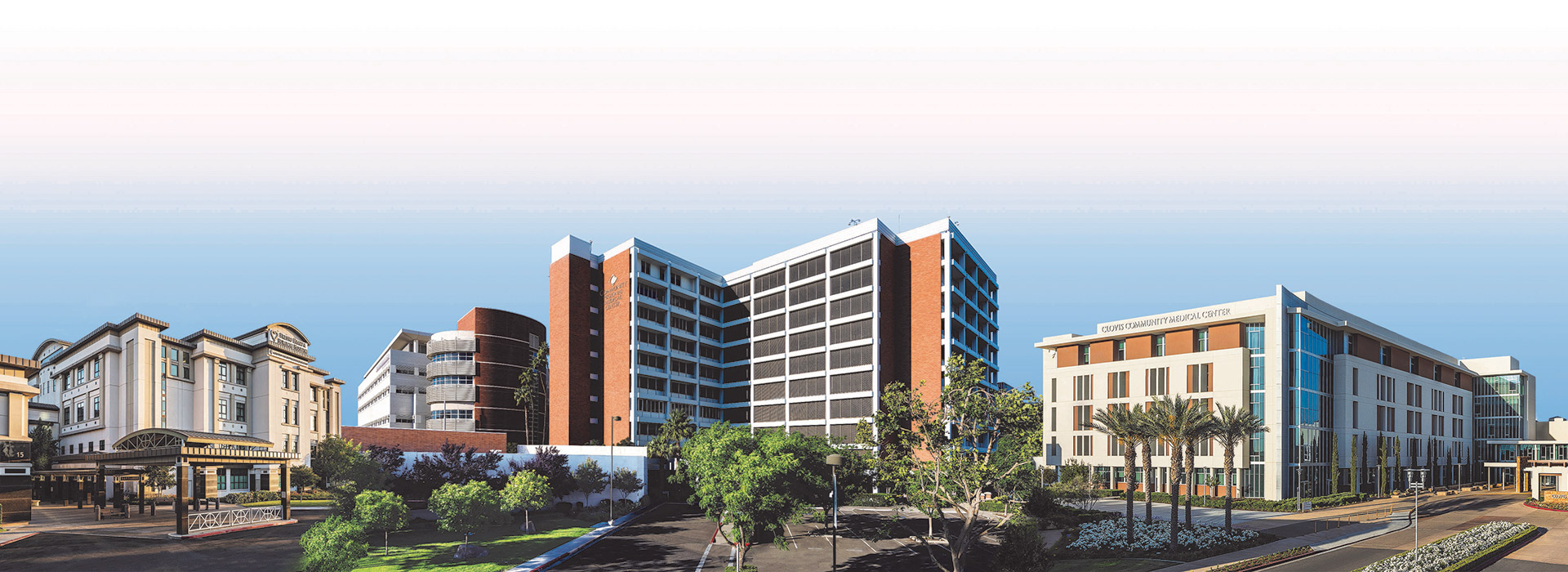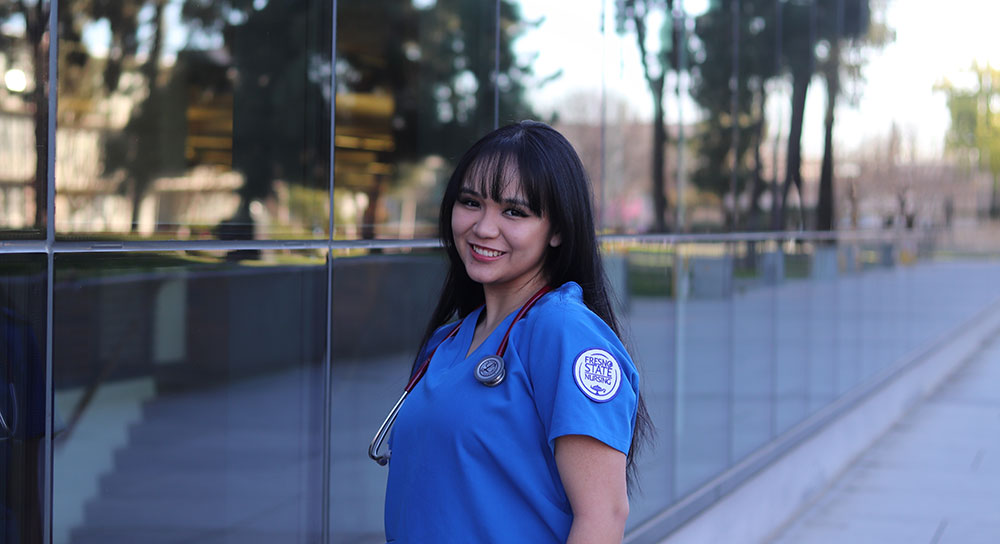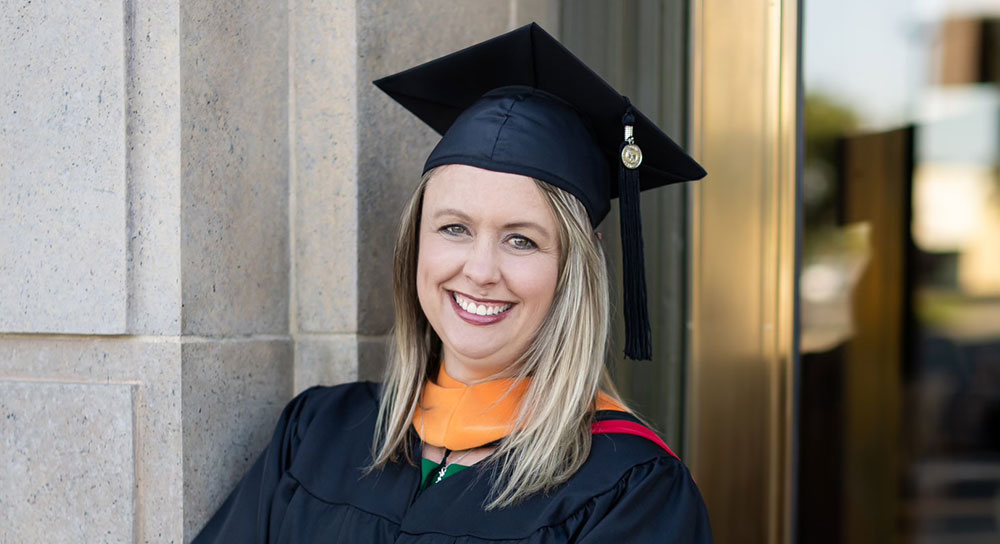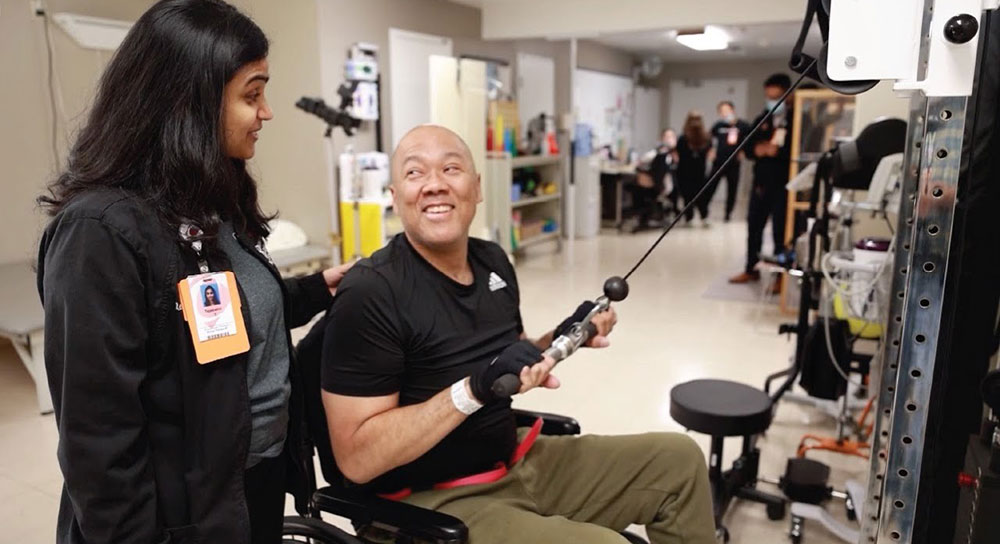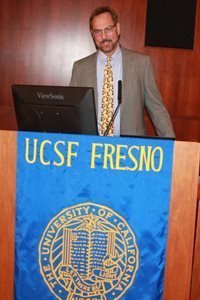 |
| Dr. John Peabody, president of QURE Healthcare and professor at UCSF and UCLA. |
This month, Community Regional Medical Center and UCSF Fresno partnered to hold their second annual Quality Improvement and Innovation Symposium where Dr. John Peabody, president of QURE Healthcare and professor at UCSF and UCLA, gave a dynamic keynote address on the status of healthcare today, where healthcare is headed, and tips to enhancing our community and physician engagement efforts in light of change. Dr. Peabody’s visit to our campus was highly anticipated by many – including key event organizers Drs. Ednann Naz and Dominic Dizon. Both stated that Dr. Peabody’s lecture was “relevant” and that it was “very good and appropriate timing.”
To impress and be impressed
Dr. Peabody’s visit just happened to be on the day and within the very hour that Congress passed a bill to overturn and replace the Affordable Care Act with a new national healthcare policy. “My excitement comes from the fact that with the current policy changes coming from the top – which are very important to us all – we must not worry, but persevere in the face of these uncertain and changing times. We still have to take care of our patients and our communities.” Dr. Peabody complemented Community Regional’s clear purpose in doing just that stating, “What I love about CRMC is that it’s an institution with a clear purpose. They take care of populations that are ignored, underserved, populations outside of their area, and the Medicare population – all with enormous health care needs. It is health care provided by a facility that has to be very careful with the resources it has and husband those resources to provide high quality care.”
Not only did Dr. Peabody impress the leadership, physicians, residents and staff with his knowledge, expertise and genuine warmth, he was equally impressed with them. “So, it’s exciting for me, as an expert in quality, to come to CRMC – to a place that’s always going to struggle to have enough resources to take it on, yet this is their priority – ‘how to standardize practice.’ It’s pretty exciting to be here.”
Importance of standardizing practice
Dr. Peabody said “The leadership here knows that standardizing practice isn’t free – it takes some investing – but ultimately, it’s the best way to lower costs without sacrificing the wellbeing of the patient.” For Dr. Dizon, the most important takeaway for everyone to know is that “standardization is good for a health system – that it actually does improve quality.” He said “For me, quality and costs are really two sides of a coin – you improve quality and then eventually, you reduce costs.” One of the first things Dr. Dizon would like to do to work towards standardization is to “implement a clinical practice guideline in form of videos. Some physicians will adopt it easily but for some, it will take us some time,” he said.
A focus on physician wellbeing
For Dr. Naz, physician wellbeing will be an important focus going forward. With physician burnout being a hot topic these days, Dr. Naz feels, from his physician perspective, “how well you treat yourself is how well you’ll treat your patients. It’s interesting, but your mindset must be on how you want to be treated.”
We all want to know that what we work hard at every day is truly meaningful work. Otherwise, why are we doing it in the first place? Dr. Naz said “Exactly. Burnout studies do show that doctors often wonder if they’re making a difference – and that’s because they want to feel their work is meaningful to themselves and that they are making a difference.”
Quality improvement and innovation at work
Dr. Peabody also gladly participated as a judge in the symposium’s annual Quality Improvement Poster Contest. For Drs. Naz and Dizon, this was a huge opportunity to have a third party-outsider perspective. This year there were 16 quality improvement projects that widely varied by topic and were entered by collaborative teams formed by UCSF medical residents, nursing, critical care, pharmacy and respiratory therapy staff of Community Regional. This was the second year of the collaborative opportunity for UCSF Fresno residents and CRMC staff to work together on research and presentation of their project – each hoped to land in the top three to earn approval for the financial backing that would ensure their projects come to fruition. Dr. Naz said “There are really cool projects here today. We will pick three winners but all 16 posters are meaningful and show the invaluable work being done here at CRMC.”
2017 contest winners
1st place: Extra Corporeal Membrane Oxygenation (ECMO): Why a Dedicated Team Improves Outcomes
Presented by: UCSF Fresno’s Internal Medicine residents with Community Regional’s pulmonary and critical care teams collaborating. (Deepti Mudkur, Chirag Rajyaguru, Faye Pais, Karamjit Dahliwal-Binning, Mohammed Fayed and Timothy Evans.)
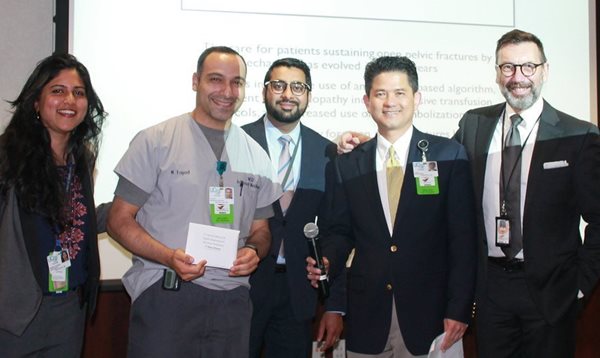
2nd place: Radiation Dose Reporting Improvement
Presented by: The orthopedic surgery department in collaboration with Community Regional’s radiology department. (Daniel Brown, M.D., and Lisa Husak, MPH CCRP, a research coordinator for UCSF.)
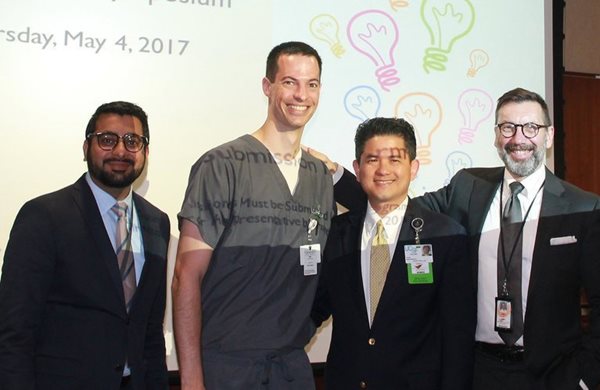
3rd place: Syphilis during pregnancy: one- versus three-dose benzathine penicillin G regimen, and subsequent diagnosis of congenital syphilis.
Presented by: The obstetrics and gynecology residency program. (Attending physician Anubhav Agrawal and resident Andrea Seid, D.O.)
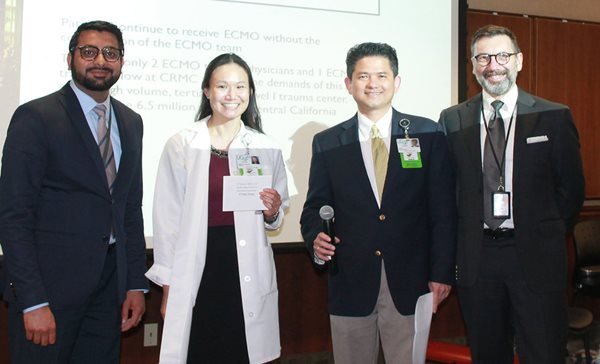
Shannon Merritt
Sr. Communications Specialist
Community Medical Centers
About the 3 winning projects and winners
1. The first place poster winner was produced by internal medicine residents with Community Regional’s pulmonary and critical care teams collaborating. The project “Extra Corporeal Membrane Oxygenation: Why a Dedicated Team Improves Outcomes” proposed standards to increase survival rates for critically ill patients who have to use the heart-lung bypass support. Kudos to presenters Deepti Mudkur, Chirag Rajyaguru, Faye Pais, Karamjit Dahliwal-Binning, Mohammed Fayed and Timothy Evans!
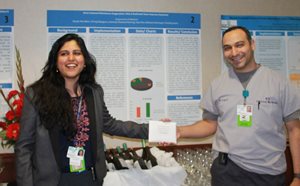 Their work increased survival rates for these critically ill patients from 33% to 46% by creating more collaboration from an inter-disciplinary team. The extracorporeal membrane oxygenation (ECMO) team approach included 24-hour coverage by an ECMO-trained physician, critical care specialists, a thoracic or trauma surgeon, a biomedical engineer for technical support, a palliative care specialist, an ECMO transport team and an ECMO coordinator who is a nurse or respiratory therapist with a strong ICU background.
Their work increased survival rates for these critically ill patients from 33% to 46% by creating more collaboration from an inter-disciplinary team. The extracorporeal membrane oxygenation (ECMO) team approach included 24-hour coverage by an ECMO-trained physician, critical care specialists, a thoracic or trauma surgeon, a biomedical engineer for technical support, a palliative care specialist, an ECMO transport team and an ECMO coordinator who is a nurse or respiratory therapist with a strong ICU background.“We’ve just had 24 possible patients since ECMO team was introduced,” said Dr. Mudkur, a first year internal medicine resident who has a master’s in clinical research from UC San Diego. She was excited to get the chance to do this kind of research with UCSF Fresno here at Community Regional. “We found that survival improved even on patients who we decided not to put on ECMO.”
Dr. Mudkur said the collaborative team approach on critically ill patients seems to be making the difference. “The way it happens, one of the doctors gets a really sick patient that they think might be a candidate for ECMO and consults the team. The team works on what might be missing in the ICU care before they decide if ECMO is necessary and sometimes it isn’t. The biggest issue is knowing which patients need to be on ECMO. Having a palliative care doctor involved helps to be able to say if the family has told him that a patient doesn’t like the quality of life they have now and if ECMO isn’t going to help fix that then we have to decide if it’s worth it. Or if the patient is at the end stages of cancer, will it help?”
ECMO is a treatment that uses a pump to circulate blood through an artificial lung back into the bloodstream to provide both cardiac and respiratory support to patients whose heart and lungs are weak or failing or are recovering from heart surgery. While ECMO has been used since the early 1970s for newborns, UCSF physicians have begun using this technology earlier and with a broader range of patients, including as a bridge for those awaiting lung transplants or LVAD (left ventricular assist device) insertion.
The winning team recommends increasing the number of ECMO trained physicians to meet the demands of a high-acuity, high-volume Level 1 trauma center like Community Regional which covers a 15,000-square-mile region. It also recommends ensuring an adequate number of ECMO machines is readily available with a biomedical engineer on call for mechanical support.
2. The second place poster winner detailed “Radiation Dose Reporting Improvement” in the orthopedic surgery department in collaboration with Community Regional’s radiology department. Presenters were Daniel Brown, M.D., and Lisa Husak, MPH CCRP, a research coordinator for UCSF.
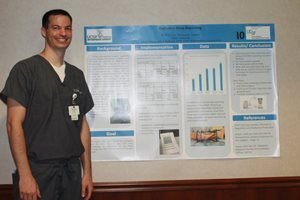 Dr. Brown discovered that radiation dosages patients were exposed to during flouroscopy scans in surgery were not being uploaded to the Synapse system so that cumulative radiation exposure could be measured.
Dr. Brown discovered that radiation dosages patients were exposed to during flouroscopy scans in surgery were not being uploaded to the Synapse system so that cumulative radiation exposure could be measured.“It took a very small intervention with Dr. Brown meeting with the radiology department manager and creating educational fliers for employees to get 100% compliance,” said Husak. “Now if someone is having a ton of operations then they can see if they’ve had too much radiation and adjust the exposure. Each fluoroscope is very minimal but if you’re going through a lot of surgeries or having other kinds of radiation treatments then it matters.”
In addition to increasing reporting frequency, the CRMC radiology department identified additional parameters and metrics that they have now included in their internal data collection for both monitoring and improvement. The presenters are going to continue tracking this to make sure the education is effective and compliance continues and are additionally considering analyzing reporting rates at Clovis as well as in other departments.
3. The third place poster from the obstetrics and gynecology residency program was “Syphilis during pregnancy: one- versus three-dose benzathine penicillin G regimen, and subsequent diagnosis of congenital syphilis.”
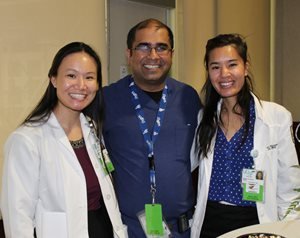 Attending physician Anubhav Agrawal and resident Andrea Seid, D.O., looked at whether babies would be born infected with syphilis if their mothers did not get the CDC-recommended minimum of three doses of penicillin. “Sometimes these pregnant mothers only get one dose because they don’t follow through or because they show up so late with syphilis that they deliver without getting the three full courses,” explained Dr. Agrawal. “They need three doses a week apart over three weeks.”
Attending physician Anubhav Agrawal and resident Andrea Seid, D.O., looked at whether babies would be born infected with syphilis if their mothers did not get the CDC-recommended minimum of three doses of penicillin. “Sometimes these pregnant mothers only get one dose because they don’t follow through or because they show up so late with syphilis that they deliver without getting the three full courses,” explained Dr. Agrawal. “They need three doses a week apart over three weeks.”Congenital syphilis in the central San Joaquin Valley is increasing dramatically with Fresno County having the highest rates in the state, the presenters wrote on their poster. The rate of congenital syphilis in Fresno County is more than triple that of California as a whole. Currently guidelines for the treatment of maternal syphilis vary on the timing and duration of disease and the presenters said uncertainty remains about the optimal treatment regimen.
The preliminary data with a small sample showed that three newborns whose mothers had two doses or one of penicillin within a month of delivering did not develop congenital syphilis. Syphilis in babies can cause developmental delays, seizures, anemia, jaundice and much more critical problems including deformities.
Click here to see all poster projects submitted. All projects will be supported by Community Regional to help presenters to further develop and strengthen their ideas, and help move their quality improvement work forward.
Erin Kennedy
Sr. Communications Specialist
Community Medical Centers

